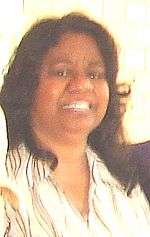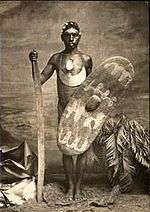Henrietta Marrie
| Henrietta Marrie | |
|---|---|
 | |
| Born |
Henrietta Fourmile Yarrabah, Queensland |
| Residence | Cairns |
| Nationality | Yidinji |
| Other names | Bukal |
| Citizenship | Australian |
| Education | Diploma Teaching, Graduate Diploma Teaching, Masters in Environmental and Local Government Law |
| Occupation | Associate Professor, Central Queensland University |
| Employer | Central Queensland University |
| Known for | Promoting and advocating indigenous cultural rights |
| Home town | Yarrabah, Queensland |
| Spouse(s) | Adrian Marrie |
Henrietta Marrie (née Fourmile) (born 1954) is an Australian indigenous rights activist. She is an Aboriginal Australian from the Yidinji tribe, directly descended from Ye-i-nie, an Aboriginal leader in the Cairns region.[1][2]
She is an advocate for the rights of her own Gimuy Walubarra Yidinji families, as well as for the cultural rights of indigenous peoples nationally and internationally.
The "Encyclopaedia of Aboriginal Australia" identifies Henrietta Marrie as a notable Aboriginal Australian in an entry that reads, in part, as follows:[3]
Fourmile has been involved in extensive research in the areas of Aboriginal cultural heritage and museums, the politics of Aboriginal heritage and the arts and recently the area of Aborigines and cultural tourism.
She has been a senior fellow at the United Nations University and an Adjunct Associate Professor with the Centre for Social Responsibility in Mining at the University of Queensland.[4] She is currently Associate Professor, Office of Indigenous Engagement at the Cairns campus of the Central Queensland University.[5]
Country
Henrietta Marrie's country within local Aboriginal tradition,[6] to which she holds some property rights under Native Title law, is that country that was once wholly possessed, occupied, used and enjoyed by 'King' Ye-i-nie' and the Walubarra Yidinji families generally, as follows:
The area of the foreshore of the City of Cairns was traditionally known as Gimuy – after the Slippery Blue Fig Tree. The traditional lands of the Gimuy Walubara Yidinji People extend south of the Barron River to Wrights Creek (south of Edmonton), west into the ranges behind Cairns, and east into Trinity Inlet, including Admiralty Island, to the adjacent waters of the outer Great Barrier Reef. The lands in the Cairns suburb of Woree, close to Admiralty Island and Trinity Inlet, were the principal traditional camping grounds of the Gimuy Walubara Yidinji people.[7]
Biographical details

Henrietta Marrie was born and raised in Yarrabah, Queensland (an Aboriginal community approx 7 km south-east of Cairns[3]), the eldest daughter of Henry Fourmile (aka Queballum – cyclone),[8] grandson to the Yidinji warrior Ye-i-nie (Aboriginal Peace Maker and 'King' of Cairns).[9]
She went to school in Yarrabah, and later studied teaching at the South Australian College of Advanced Education, where she first obtained a Diploma in Teaching.[3] Later, after the College had been transformed into the University of South Australia, she obtained a Graduate Diploma of Arts (Indigenous Studies).[6]
By 1988 Henrietta Marrie was lecturing at Griffith University, Brisbane, and in 1991 had managed to return to Cairns (Gimuy) region, where she first assisted co-ordinate the Cairns College of Technical and Further Education's Aboriginal ranger training program, then by 1994, had become the Cairns Coordinator of a new Aboriginal and Torres Strait Islander Participation, Research and Development Centre in James Cook University.[3]
From Cairns, Henrietta Marrie undertook at Masters in Environmental and Local Government Law (through Macquarie University). Her interests and concerns moved to biocultural diversity, indigenous intellectual property, and traditional ecological knowledge,[10] and as such, by 1997, she had moved on and taken up a position with the United Nations Secretariat for the Convention on Biological Diversity, where she was the first Aboriginal Australian to be appointed to a full-time professional position in a United Nations agency.[10]
Since 2003, Henrietta Marrie moved her focus back towards Cairns and first working as the Christensenfund's North Australian Program Officer assisting that philanthropic organisation distribute grants and funds to help promote, sustain, and encourage indigenous biocultural diversity across Australia's north (including the Cairns region).,[10] now working as an Associate Professor at the Central Queensland University's Cairns campus
Publications
- Fourmile, Henrietta (1987). Racism in legislation : the bill for the South Australian Aboriginal Heritage Act 1987.
- Fourmile, Henrietta (1987), "Aborigines and Museums: A Case Study in Scientific Colonialism", Praxis (17): 7–11
- Fourmile, Henrietta (1989), "Aboriginal Heritage legislation and Self-Determination", Australian-Canadian Studies, 7 (1–2)
- Fourmile, Henrietta (1989), "Who Owns the Past?: Aborigines as Captives of the Archives", Aboriginal History, 13: 1–8
- Fourmile, Henrietta (1989), "Aboriginal arts in relation to multiculturalism", in Cramer, Sue, Postmodernism : a consideration of the appropriation of Aboriginal imagery : forum papers, Brisbane: Institute of Modern Art
- Fourmile, Henrietta (1990), "Possession is nine-tenths of the law: And don't Aboriginal people know it", Bulletin of the Conference of Museum Anthropologists
- Fourmile, Henrietta (1990), "The Case for Independent but Complementary Aboriginal Cultural Institutions", Extending Parameters: Galleries and Communities
- Hall, Doug; Fourmile, Henrietta, eds. (1990), Trevor Nickolls : gondola dreaming and other dreams, Queensland College of Art Gallery
- Fourmile, Henrietta (1992), "The Need for an Independent National Inquiry into State Collections of Aboriginal and Torres Strait Islander Cultural Heritage", Aboriginal Law Bulletin (25)
- Fourmile, Henrietta (1993), "Cultural management & tourism", in Testa, Joe, [Video Recording], Lismore, NSW: Gungil Jindibah Centre, Southern Cross University
- Fourmile, Henrietta (1993). "Cultural Survival vs Cultural Prostitution". Cultural Tourism Awareness Workshop on Indigenous Cultural Tourism in Far North Queensland.
- Fourmile, Henrietta (1993). "Representing Kunggandji/Yidinji". Julayinbul Conference on Intellectual and Cultural Property.
- Henrietta, Fourmile, Submission : inquiry into Aboriginal and Torres Strait Islander Culture and Heritage, House of Representatives Standing Committee on Aboriginal and Torres Strait Islander Affairs.
- Moscardo, G.; Pearce, P.L.; Birtles, A.; Valentine, P.; Fourmile, H.; Burns, D.; Young, M.; Haxton, P. (1994), "Rainforest tourism: Research for Quality Tourism Management", Annual Meeting of the CRC-TREM
- Fourmile, Henrietta (1996) "Making Things Work: Aboriginal and Torres Strait Islander Involvement in BioRegional Planning" Biodiversity Series Paper No. 10. Department of Environment, Sport & Territories (pdf) Accessed 12 October 2008
References
- ↑ The Queensland Government, in 1905, awarded Ye-i-nie with a king plate in recognition of his local status as a significant Walubara Yidinji leader – see AIATSIS (2007) "Welcome – 2007 Native Title Conference" Accessed 19 October 2008
- ↑ Brisbane Festival 2009 "Red Box Lecture, state Library of Queensland" webpage Accessed 3 October 2009
- 1 2 3 4 Bancroft, R (1994) "Fourmile, H" in Horton (General Editor) The Encyclopedia of Aboriginal Australia: Aboriginal and Torres Strait Islander History, Society, and Culture Aboriginal Studies Press. Canberra. ISBN 0-85575-234-3
- ↑ http://www.csrm.uq.edu.au/people/369-henrietta-marrie
- ↑ http://www.cairnslifemag.com.au/august-2015/cbwc-henrietta-fourmile-marrie
- 1 2 GEDO EcoDesign Webpage '2006 Global EcoDesign Dialogues Speaker Profiles' Accessed 21 October 2008
- ↑ AIATSIS(2007) "Welcome – 2007 Native Title Conference" Accessed 19 October 2008
- ↑ Wilson, Bill (2005) "Our Vision and Our Journey – Sharing a Learning Culture" in Australian National Training Authority's Learning Culture – The Way Forward Accessed 20 October 2008
- ↑ South Australian Museum on-line Exhibition Kong Ye-i-nie photo and caption Accessed 19 October 2008
- 1 2 3 Christensfund's Program Officer Biographies page Accessed 6 December 2008
External links
- Profile on Queensland Government's Indigenous Arts Marketing and Export Agency Webpage Accessed 30 September 2008
- Profile on Australian Environmental Grantmakers Network Webpage Accessed 30 September 2008
- Brisbane Festival 2009 "Red Box Lecture, state Library of Queensland" webpage Accessed 3 October 2009